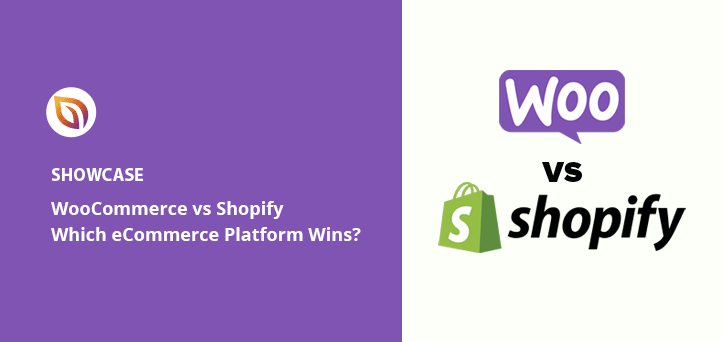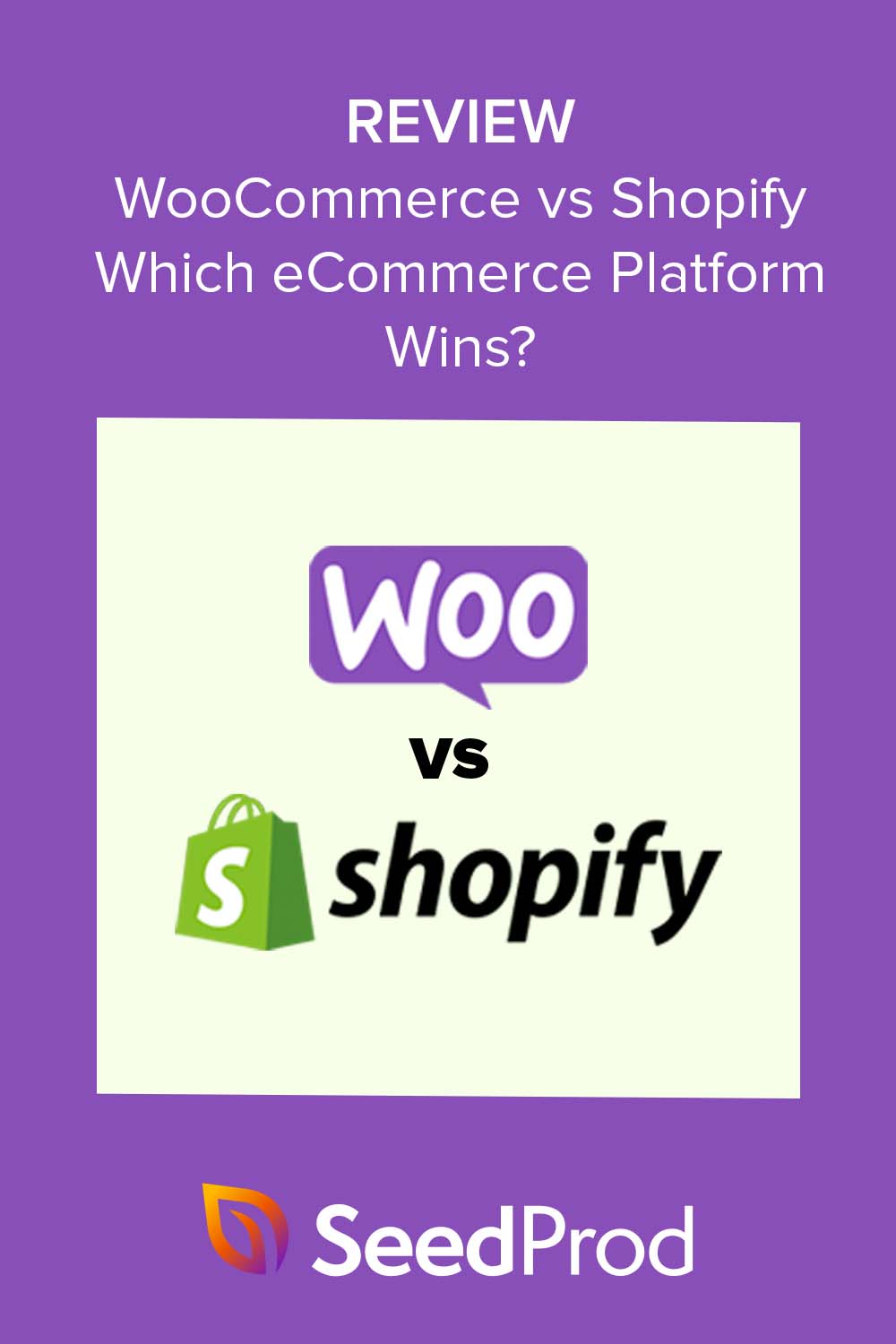Are you starting an online store and struggling to choose between WooCommerce and Shopify? This is a common challenge, as they’re two of the most popular eCommerce platforms, each with its own set of pros and cons. Making the right choice for your business is crucial.
That’s where this WooCommerce vs Shopify comparison comes in. We’ll explore the differences and similarities between these leading platforms, helping you determine the best fit for your specific needs and make an informed decision for your online business.
Da es sich hier um einen detaillierten Vergleich von Shopify und WooCommerce handelt, finden Sie hier ein Inhaltsverzeichnis, damit Sie den gewünschten Abschnitt leichter finden:
- WooCommerce vs. Shopify: An Overview
- WooCommerce vs Shopify: Key Considerations
- WooCommerce or Shopify: Which is Cheaper?
- WooCommerce vs. Shopify: Which is Easier?
- Payment Options: Flexibility vs Convenience
- Add-ons and Integrations: Extending Functionality
- WooCommerce vs. Shopify for Dropshipping
- WooCommerce vs. Shopify: Scaling Your Business
- Support Services: Finding Help When You Need It
- WooCommerce vs. Shopify: The Best Platform in 2025
WooCommerce vs. Shopify: An Overview
Before we dive into the details, let’s clarify what makes WooCommerce and Shopify unique in the world of eCommerce website builders. Understanding these differences is key to deciding which platform is right for you.
Was ist WooCommerce?

WooCommerce is a free, open-source eCommerce plugin designed to transform your WordPress website into a fully functional online store.
As a self-hosted platform, WooCommerce offers unmatched customization. You have full control over your website’s design (using WordPress themes), functionality (with thousands of WordPress plugins), and data.
Because of its flexibility, WooCommerce has become incredibly popular. It’s now the most widely used eCommerce platform worldwide, even surpassing Shopify in market share.
Was ist Shopify?

Shopify takes a different approach. It’s a fully hosted, all-in-one eCommerce platform that prioritizes ease of use. With Shopify, you don’t need to worry about technical details like web hosting, security, or software updates – Shopify handles it all for you.
This makes Shopify an excellent option for beginners or anyone who wants to launch their online store quickly and easily. You get everything you need in one place to start selling online, from customizable Shopify themes to integrated payment processing.
Ultimately, the choice between WooCommerce and Shopify comes down to your priorities: customization and control versus convenience and simplicity. Let’s explore these platforms in detail to help you decide which approach aligns best with your business needs.
WooCommerce vs Shopify: Key Considerations
Making the right decision for your online store starts with understanding the key factors that differentiate eCommerce platforms. As you weigh the pros and cons of WooCommerce vs Shopify, consider the following:
- Pricing: How much will it cost to launch and maintain your online store? Be sure to factor in costs for hosting, themes, plugins/apps, and transaction fees. Shopify pricing vs. WooCommerce pricing can vary significantly, so a thorough analysis is essential.
- Ease of Use: How user-friendly is the platform? Is it suitable for beginners with limited technical experience? WooCommerce vs Shopify for beginners is a common point of comparison.
- Payment Gateways: Which payment methods can you accept? A variety of options is crucial for catering to diverse customer preferences.
- App Integrations: Does the platform seamlessly integrate with essential business tools like email marketing services, analytics platforms, and more?
- Scalability: Can the platform grow with your business? As your sales and traffic increase, you need a solution that can handle the demands. Is WooCommerce or Shopify better for scaling a growing business is a question many entrepreneurs face.
We’ll delve into each of these aspects in our WooCommerce vs Shopify comparison, providing you with the insights you need to choose the best platform for your unique business goals.
WooCommerce or Shopify: Which is Cheaper?
One of the most critical factors in the WooCommerce vs Shopify debate is cost. “Which is cheaper, Shopify or WooCommerce?” is a question on many entrepreneurs’ minds. Let’s break down the pricing structure of each platform:
Die Kosten für die Verwendung von WooCommerce
The beauty of WooCommerce is that the core software is free. That’s right, both WordPress (the content management system WooCommerce runs on) and the WooCommerce plugin itself is open-source and free to download.
However, don’t mistake “free” for “no cost.” To get your WooCommerce store up and running, you’ll need:
- WooCommerce Hosting: This is where your website files are stored and is a recurring cost.
- Domain Name: This is your store’s address on the internet (e.g., www.yourstore.com).
- SSL Certificate: Essential for security, ensuring your customer data is encrypted.
While these costs can add up, several specialized WooCommerce hosting providers offer affordable packages that bundle everything you need. For example, Bluehost has plans starting as low as $2.75 per month, making it an incredibly budget-friendly option for starting your online business.

Keep in mind that while WooCommerce itself doesn’t charge transaction fees, your chosen payment gateway (like PayPal or Stripe) will. As your store grows, you might also invest in premium WordPress themes and plugins for enhanced design and functionality, adding to your expenses.
Die Kosten der Nutzung von Shopify
Shopify’s pricing is more straightforward: you pay a fixed monthly fee based on your chosen plan:
- Basic Shopify: $19/month
- Shopify: $49/month
- Advanced Shopify: $299/month
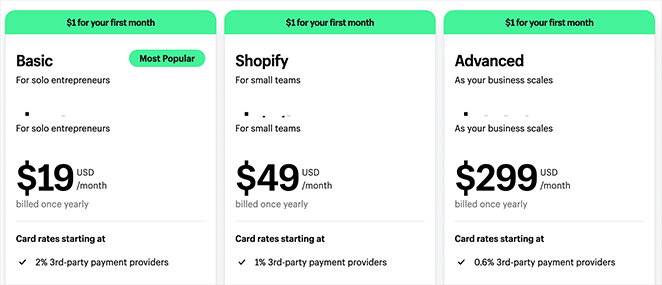
The good news is that Shopify’s monthly fees include hosting, an SSL certificate, and access to basic features. However, you’ll still need to buy a custom domain name.
Shopify also offers a Shopify Lite plan for $5/month, allowing you to add a buy button to an existing website or sell in person using Shopify POS.
It’s essential to factor in Shopify’s transaction fees. While using Shopify Payments (their built-in payment processor) avoids additional transaction fees beyond standard credit card processing rates, opting for third-party payment gateways will incur an extra fee on top of the provider’s charges.
Gewinner
Deciding whether WooCommerce or Shopify is cheaper depends on your specific needs and circumstances. WooCommerce often has a lower upfront cost, especially for small businesses. However, Shopify offers predictable monthly pricing, which can be appealing to businesses that value simplicity and transparency.
WooCommerce vs. Shopify: Which is Easier?
For many businesses, ease of use is a top priority when choosing an eCommerce platform. Let’s address the common question: Which is easier, WooCommerce or Shopify?
Als Nächstes wollen wir sehen, wie einfach die einzelnen Plattformen zu bedienen sind.
WooCommerce Benutzerfreundlichkeit
Da WooCommerce eine selbst gehostete Plattform ist, müssen Sie das WooCommerce-Plugin installieren, Ihre Website sichern, Updates verwalten und Ihren Shop sichern. Es gibt jedoch zahlreiche kostenlose und kostenpflichtige WordPress-Plugins, die diese Aufgaben für Sie automatisieren können.
Wenn es um die Anpassung Ihres Shops geht, ist WooCommerce sehr flexibel. Sie haben die vollständige Kontrolle über alles und können Ihre Website mit mehr als 59.000 WordPress-Plugins erweitern.
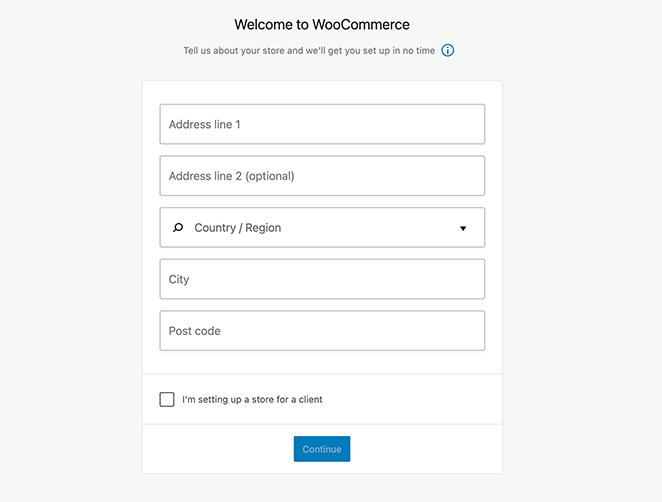
Das heißt, WooCommerce wird nicht mit einem Drag-and-Drop-Seitenerstellungsprogramm geliefert. Für visuelle Bearbeitungsfunktionen können Sie einen WordPress-Seitenersteller wie SeedProd oder Beaver Builder verwenden, die jedoch die Gesamtkosten Ihrer Website erhöhen.
A downside to WooCommerce’s flexibility is the learning curve. You’ll need to be more hands-on with website management and sign up for a merchant account or with services like PayPal or Stripe.
Shopify-Benutzerfreundlichkeit
Im Vergleich zu WooCommerce ist Shopify eine vollständig gehostete Plattform, so dass Sie sich nicht um Updates kümmern oder zusätzliche Funktionen installieren müssen. Sie müssen sich auch keine Gedanken über Backups, Sicherheit, Leistung oder Kompatibilität mit Add-ons oder Erweiterungen machen.
Nachdem Sie sich bei Shopify angemeldet haben, können Sie aus vielen kostenlosen Shopify-Themen wählen. Die kostenlosen Themes sind elegant und vielseitig und enthalten alle notwendigen Designfunktionen. Alternativ können Sie auch Vorlagen aus dem kostenpflichtigen Themeshop auswählen.
Sie führen Sie dann durch den Einrichtungsprozess, einschließlich der Anpassung Ihres Shops und dem Hinzufügen von Produkten.

Shopify has a drag-and-drop visual interface, and managing product pages, inventories, and sales is just as easy.
Der einzige Nachteil dieser einfachen Benutzererfahrung ist die mangelnde Kontrolle, die Shopify den Benutzern über bestimmte Aspekte ihres Shops gibt. So können Sie beispielsweise nur Shopify-Themen, die eigenen Entwicklungstools oder die auf dem Shopify-App-Marktplatz verfügbaren Tools verwenden.
Gewinner
We think Shopify is the winner regarding ease of use. Although WooCommerce offers more flexibility and control, Shopify makes the setup process easy and hassle-free without a steep learning curve.
Payment Options: Flexibility vs Convenience
Offering your customers a variety of secure and convenient online payment methods is essential for any successful eCommerce website. So, how do WooCommerce and Shopify stack up in terms of payment gateway options?
WooCommerce-Zahlungsmethoden
WooCommerce provides an extensive range of payment gateways, giving you the freedom to choose the best options for your business and your customers.
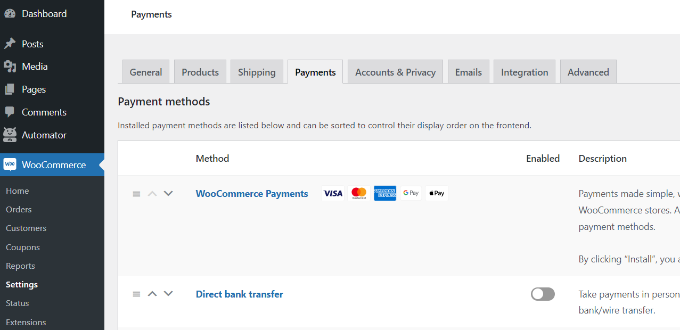
Additionally, WooCommerce supports virtually every other payment service provider imaginable. You can install Square, Amazon Pay, Authorize.net, Alipay, and more integrations.
WooCommerce unterstützt auch mehrere weniger populäre und regionale Zahlungsgateways. Ohne Einstiegshürde kann jeder Zahlungsanbieter ein WooCommerce-Zahlungs-Add-on erstellen und unterstützen.
Wenn es um Zahlungsgebühren geht, wird Ihnen nur eine Transaktionsgebühr von Ihrer Bank oder Ihrem Zahlungs-Gateway berechnet. Sofern Sie nicht die WooCommerce-Zahlungsoption verwenden, wird WooCommerce Ihnen niemals eine prozentuale Gebühr für Kreditkartenzahlungen berechnen.
Shopify-Zahlungsmethoden
Kunden können in Ihrem Shopify-Shop mit verschiedenen Zahlungsmethoden zur Kasse gehen. Shopify hat seine eigene "Shopify Payments"-Lösung, die von Stripe unterstützt wird, sowie viele der beliebtesten Drittanbieter-Zahlungsgateways.
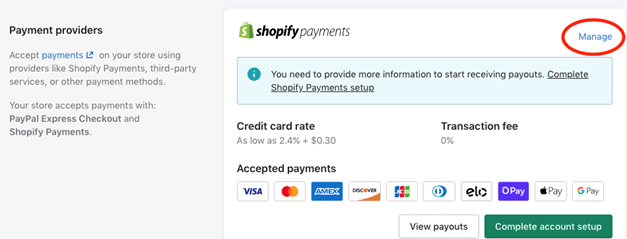
Allerdings erhebt Shopify eine zusätzliche Transaktionsgebühr von 2 % für jede Transaktion, die über Drittanbieter-Gateways durchgeführt wird. Diese Gebühr kommt zu den Gebühren hinzu, die von den einzelnen Zahlungs-Gateways erhoben werden. Wie bereits erwähnt, können Sie diese Gebühren auf 0,05 % reduzieren, indem Sie ein Upgrade auf den Shopify Advanced Plan für 299 $ pro Monat vornehmen.
Shopify Payments hat auch Kreditkartengebühren, aber keine anderen Gebühren oder Transaktionen. Die Gebühren beginnen bei 2,9 % + 30 Cent für den Basisplan von Shopify und werden bei den teureren Plänen niedriger.
Gewinner
Es ist nicht einfach, sich für einen Gewinner zu entscheiden, wenn es um die Zahlungsmöglichkeiten geht.
Sie können in WooCommerce Geld sparen, indem Sie Ihr eigenes Händlerkonto wählen und ein Gateway eines Drittanbieters verwenden. Wenn Sie ein kleiner Online-Shop sind, der Shopify Payments verwendet, sind die Kreditkartentarife die gleichen wie bei PayPal und Stripe, es gibt also kaum einen Unterschied.
In diesem Fall sind WooCommerce und Shopify bei den Kriterien für die Zahlungsarten gleichauf.
Add-ons and Integrations: Extending Functionality
As your eCommerce business grows, you’ll need more than just the core features of your chosen platform. Integrations with marketing automation tools, analytics platforms, CRM systems, and other business-critical software become essential for streamlining operations and driving growth.
Let’s explore how WooCommerce and Shopify compare in terms of extending functionality through add-ons and integrations.
WooCommerce-Integrationen
Da WooCommerce Open-Source ist und auf dem WordPress CMS aufbaut, hat es Zugang zu über 59.000+ kostenlosen WordPress Plugins und unzähligen weiteren kostenpflichtigen Plugins.
Mit diesen Add-Ons können Sie Ihre WooCommerce-Website mit Zahlungsgateways, Suchmaschinenoptimierung (SEO), Lead-Generierung, Leistungsoptimierung, Social-Media-Integrationen und jeder anderen Funktion, die Sie sich vorstellen können, erweitern.

Außerdem gibt es für WooCommerce viel mehr Integrationen und Add-ons als für Shopify, weil die Einstiegshürde so niedrig ist. Praktisch alle Tools und Dienste von Drittanbietern verfügen über eigene Plugins zur Integration in Ihren WooCommerce-Shop.
Shopify-Integrationen
Shopify’s app store takes a more curated approach. The store features a wide array of integrations with popular marketing, sales, and business management tools.

Sie bieten beispielsweise eine OptinMonster-Integration für die Lead-Generierung, mit der Sie die Zahl der abgebrochenen Warenkörbe verringern und Ihre E-Mail-Liste vergrößern können. Sie finden auch Apps für Produktbewertungen, Suchmaschinenoptimierung, Rabatte und mehr.
The Shopify app store offers free and paid apps. The free apps are typically from third-party services with their own pricing and only integrate your store with their APIs. The pricing for paid add-ons varies, with many apps offering monthly subscriptions.
Gewinner
In diesem Szenario ist WooCommerce der Gewinner. Shopify hat weniger Erweiterungen als WooCommerce, weil es viel schwieriger ist, eine App in seinem App-Store zu platzieren.
Andererseits verfügt WooCommerce über Tausende von kostenlosen und kostenpflichtigen Integrationen, so dass es insgesamt viel einfacher anpassbar ist. Unternehmer können auch einen Webentwickler beauftragen, ein individuelles WooCommerce-Plugin oder eine Integration für ihre Website zu erstellen.
WooCommerce vs. Shopify for Dropshipping
WooCommerce vs Shopify for dropshipping is a popular debate. Dropshipping, a business model where you don’t manage inventory, relies heavily on your eCommerce platform’s capabilities. So, which platform comes out on top for aspiring dropshippers?
Dropshipping mit WooCommerce
WooCommerce ist eine sehr beliebte Wahl für Dropshipping-Unternehmen. Dies liegt vor allem daran, dass es eine Vielzahl von WooCommerce Dropshipping-Plugins bietet, die den Prozess super einfach machen.
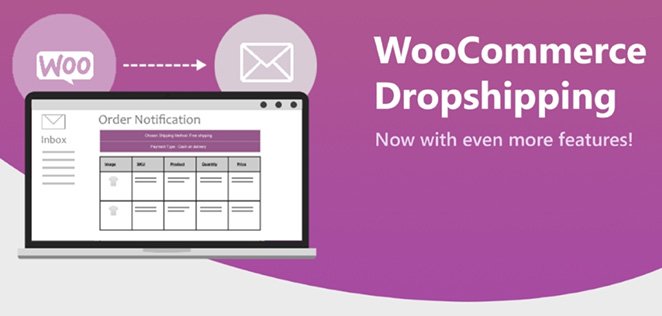
Mit einem Dropshipping-Plugin können Sie Produkte sofort importieren und Kundenbestellungen über Ihre Website ausführen. Sie können auch einen Marktplatz wie eBay einrichten, auf dem Verkäufer ihre Produkte auf Ihrer Website verkaufen können.
Dropshipping mit Shopify
When you build a dropshipping website with Shopify, the front of your site will look like any other online store. Users can browse your products, add them to their shopping carts, and make payments like any other online shop.

Danach müssen Sie die Bestellung des Benutzers für den Versand aufgeben, wobei dies von den von Ihnen verwendeten Anbietern abhängt.
Außerdem ist Shopify mit verschiedenen Dropshipping-Marktplätzen wie Oberlo, Printify und AliExpress integriert. Allerdings hat jeder Marktplatz seine eigenen Versand-, Mitgliedschafts- und sonstigen Gebühren, die von Shopify getrennt sind und die Sie genau beachten müssen.
Gewinner
Choosing between WooCommerce vs Shopify for dropshipping ultimately depends on your priorities. WooCommerce, with its flexibility and potential for cost savings, is an excellent choice for established businesses or those focused on scaling their operations. Shopify provides a more beginner-friendly and streamlined experience, making it suitable for new dropshippers.
WooCommerce vs. Shopify: Scaling Your Business
Is WooCommerce or Shopify better for scaling a growing business?” That’s the million-dollar question for ambitious eCommerce entrepreneurs. As your sales increase and your customer base expands, you need a platform that can handle the growth without compromising performance or breaking the bank.
Skalierbarkeit von WooCommerce
Da WooCommerce selbst gehostet wird, müssen Sie Ihren Hosting-Plan aktualisieren, sobald Sie mehr Website-Traffic sehen. Das liegt daran, dass die Ressourcen Ihres Starter-Hosting-Tarifs mit zunehmendem Wachstum erschöpft sein werden.
Luckily, there are many ways to handle your growth because you’re in full control of your website. Even though the hosting costs will increase, you’ll have more control over the features you upgrade without paying for resources you won’t use.

You can even use a managed WordPress hosting provider like SiteGround or WP Engine to scale your WooCommerce store more easily.
Skalierbarkeit von Shopify
Da Shopify sich um alle technischen Aspekte Ihres eCommerce-Shops kümmert, können Sie Ihren Shopify-Tarif aufrüsten, wenn Ihr Unternehmen zu wachsen beginnt. Die Infrastruktur von Shopify kann ein wachsendes Unternehmen effizient betreiben, ohne dass Sie sich um Updates, Ausfallzeiten, Backups und mehr kümmern müssen.
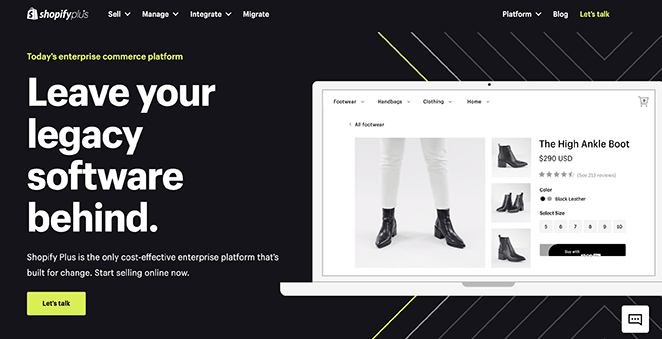
Shopify bietet sogar den Shopify Plus-Plan an, der Unternehmensdienste umfasst. Damit wird die Verwaltung Ihres Online-Shops zwar einfacher, aber die Kosten steigen mit zunehmender Größe erheblich. Dies wird jedoch dadurch kompensiert, dass Sie kein eigenes technisches Team einstellen müssen.
Gewinner
Was die Skalierbarkeit angeht, ist Shopify unserer Meinung nach der Gewinner. Obwohl WooCommerce mehr Kontrolle und Flexibilität bietet, bevorzugen viele Geschäftsinhaber den problemlosen Ansatz von Shopify.
Support Services: Finding Help When You Need It
Running an online store inevitably involves questions and the occasional technical hiccup. When those moments arise, reliable customer support can be a lifesaver. Let’s compare how WooCommerce and Shopify compare in terms of support services.
WooCommerce-Unterstützungsoptionen
WooCommerce ist die weltweit beliebteste E-Commerce-Plattform, so dass bei Bedarf unendlich viele Support-Optionen zur Verfügung stehen.
The official WooCommerce website has detailed documentation, step-by-step guides, and tutorials that help you learn. There are also support forums for help from the WooCommerce support team and other users with expert knowledge.
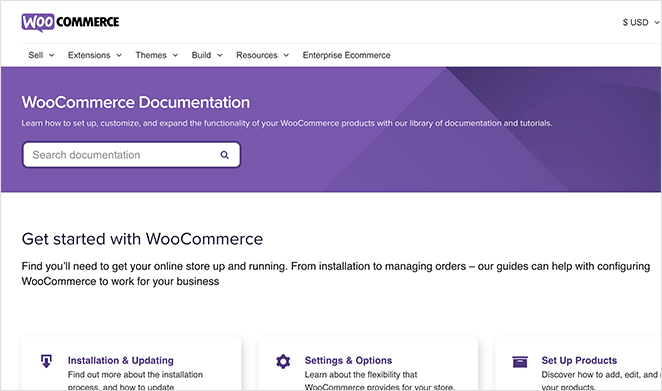
Darüber hinaus bietet WooCommerce jetzt 24/7 Chat-Support mit jeder Premium-Erweiterung oder Thema Kauf von WooCommerce.com.
Da WooCommerce jedoch selbst gehostet wird, ist Ihr Hosting-Anbieter für den Support bei Problemen mit Ihrem Server verantwortlich. Das Gleiche gilt für WordPress-Themes, Plugins und Erweiterungen von Drittanbietern.
Shopify Support-Optionen
Da Shopify vollständig gehostet wird, kontrollieren und kennen sie die Software in- und auswendig. Als solche bieten sie 24/7 Live-Chat, Telefon, E-Mail und Twitter-Kundensupport.
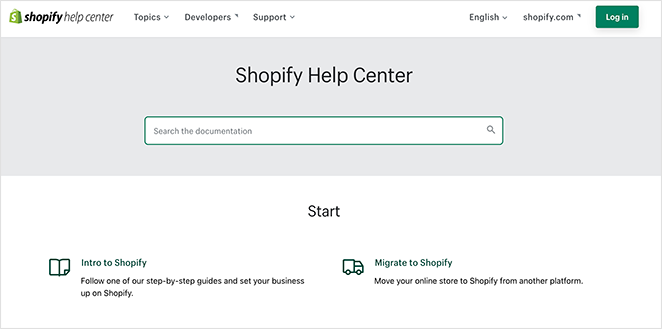
Shopify also maintains detailed documentation, a knowledge base, forums, and video tutorials for users who want to help themselves. Additionally, you can hire a Shopify Expert for extra help and support; however, it doesn’t offer support for third-party tools.
Gewinner
Shopify ist der Gewinner in der Kategorie Support-Optionen. Mit mehreren Support-Optionen und umfangreichem Wissen über sein Produkt können Shopbetreiber immer eine Lösung für ihre Probleme finden.
WooCommerce vs. Shopify: The Best Platform in 2025
So, you’ve carefully analyzed the features, pricing, ease of use, and support options for both WooCommerce and Shopify. Now comes the big question: Which eCommerce platform is the best choice for your online store in 2025?
As with most things in life, there’s no one-size-fits-all answer. The best platform depends entirely on your specific needs, priorities, and long-term vision for your business.
WooCommerce ist eine Open-Source-Lösung, die Ihnen die vollständige Kontrolle über Ihre eCommerce-Website gibt. Es kostet weniger und bietet umfangreiche Anpassungsmöglichkeiten.
The downside is you’ll need to maintain your store yourself, and it has a slight learning curve. Millions of beginner website owners are using it, and they quickly overcome the learning phase.
Im Vergleich dazu ist Shopify viel einfacher zu bedienen und erfordert keine Installation. Die Preispläne sind einfach zu verstehen, und auch die Einbindung von Zahlungsanbietern ist unkompliziert.
Allerdings haben Sie bei Shopify nicht die volle Kontrolle über Ihre Website. Die Kosten können relativ hoch werden, und die Upgrade-Optionen sind begrenzt.
Overall, WooCommerce is the best option if you want a flexible, cost-effective eCommerce solution with complete control over your site. But if you prefer a hassle-free approach to running an online store, Shopify is the best solution.
Was sind einige Alternativen zu WooCommerce und Shopify?
Wenn WooCommerce nicht Ihren Anforderungen entspricht, können Sie MemberPress, Easy Digital Downloads oder WPForms als gute Alternativen ausprobieren. Einige beliebte Alternativen zu Shopify sind Squarespace, BigCommerce und Wix.
Da haben Sie es!
Wir hoffen, dass Ihnen dieser Artikel gefallen hat und dass er Ihnen geholfen hat, die Vor- und Nachteile von WooCommerce gegenüber Shopify kennenzulernen. Sie können auch diesen Leitfaden über die besten Sales Funnel Builder lesen. Oder diesen über die besten WooCommerce Affiliate Plugins. Wir empfehlen auch diesen Leitfaden, wie man auf WordPress ohne WooCommerce verkaufen kann.
Vielen Dank fürs Lesen! Wir würden uns freuen, Ihre Meinung zu hören. Bitte hinterlassen Sie einen Kommentar mit Ihren Fragen und Ihrem Feedback.
Sie können uns auch auf YouTube, X (früher Twitter) und Facebook folgen, um weitere hilfreiche Inhalte für Ihr Unternehmen zu erhalten.

